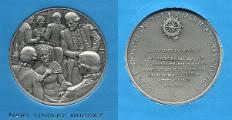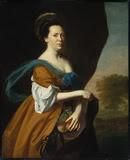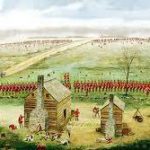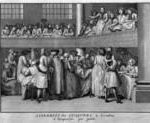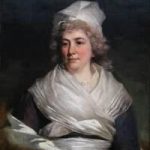Heroine of the Revolutionary War
Pewter Medallion of Mary Lindley Murray
Reverse has this inscription: “After the British had captured Manhattan Island, she delayed the enemy officers at her home. Her clever diversion permitted American troops to escape.”
Mary Lindley, born in 1726, was the daughter of Thomas Lindley, a Quaker and blacksmith who had arrived in Philadelphia from Ireland in 1719. In 1727, with a group of other Quakers, including some of the most prominent merchants of the colony, Thomas Lindley became a founding owner of the Durham Furnace on the Delaware River in Bucks County, a 6000-acre iron ore site and one of the leading forges in the colonies.
Robert Murray (1721-1786) was born to a Presbyterian family in County Armagh, Ireland, and his family emigrated to America in 1732. While still in his teens, Robert became the operator of a mill in Swatara, Pennsylvania.
In 1733, Thomas Lindley bought 480 acres of land in Paxtang Township, from Robert Murray’s residence in Swatara, and moved the family to Lancaster County. Lindley, already a man of some importance, quickly became a member of the local elite. In 1738, he became a Justice of the Peace and served in the Pennsylvania Assembly from 1739 through 1743, the year he died.
In Lancaster County, Mary Lindley met Robert Murray, a local merchant who lived a few miles away. Originally a Presbyterian, Robert became a Quaker when they were married in 1744. Robert and Mary moved to Swatara after their marriage, and their son Lindley Murray was born the following year, and he would become the second largest-selling author of the first half of the 19th century.
All his life, Robert Murray was a man who seized opportunity when it came. His marriage to Mary Lindley gave the young miller access to the top echelon of Pennsylvania’s Quaker merchants, many of whom knew Thomas Lindley not only from his Philadelphia days, but also from serving with him in the Assembly.
From at least 1745 on, Robert Murray was operating as a merchant and making trading visits to the West Indies. These early trading efforts undoubtedly capitalized on Murray’s position as a miller: flour and wheat were Pennsylvania’s major exports to the West Indies.
The couple moved to New York City in 1753 after a short residence in North Carolina. Robert Murray quickly became one of the most successful and wealthiest merchants in the city. By the time Lindley Murray was growing to young manhood, Robert Murray was an enormously wealthy and powerful figure in New York.
In about 1762, Robert rented land from the city and built an estate he named Inclenberg, Dutch for beautiful hill. The land he rented, just over 29 acres, was located in what is now Manhattan’s Murray Hill section, which is named for their family. The two-story great house was located at what is today Park Avenue and 36th Street. Grand Central Station stands on what was one of the estate’s cornfields.
Inclenberg was a square building surrounded by verandas on three sides. It was approached by an avenue of magnolias, elms, spruce and Lombardy poplars, which led to a wide lawn bordered by extensive gardens. The front windows of the spacious mansion commanded a view of Kip’s Bay and the East River. Inclenberg was frequently spoken of as one of the loveliest spots on the island.
At the beginning of the Revolutionary War, many people remained undecided about where there loyalties lay, and even those who had decided often remained polite to their opponents. It was not until later that the country became thoroughly divided.
Though her husband was a Loyalist (British supporter) and continued to buy British goods, Mary Lindley Murray was sympathetic to the Americans. Many members of her family were Revolutionaries and served in Washington’s army, and she proved to be a true patriot despite her husband’s loyalties.
Battle of Kip’s Bay
In the days following the escape of American forces after the Battle of Long Island (August 1776), the first large battle between the Continentals and the British, General George Washington sent General Israel Putnam and 5000 soldiers to New York City. In mid-September, British warships took positions on Kip’s Bay to provide protection for a flotilla of flat-bottomed boats that ferried 4000 British soliers to Manhattan.
On September 15, 1776, British troops led by General William Howe landed in Kip’s Bay, intending to attack and trap General Putnam’s troops, who were retreating in the face of far superior numbers. Mary Lindley Murray knew that Putnam’s troops were within a mile of her home and that the British troops were almost double those of Putnam’s army.
Mary stalled the British troops by inviting them to tea at Inclenberg. She and her daughters entertained them while they waited for Putnam’s troops to escape. It is said that Mary asked her maid to keep watch from an upstairs window and to let her know when the troops had safely withdrawn. Mary succeeded in delaying them long enough for General Putnam to make an orderly retreat.
The Battle of Kip’s Bay placed New York City firmly in British hands, where it would remain for the rest of the war. The city’s already large Loyalist population grew as other like-minded Americans fled there for protection.
In a journal entry on September 20, 1776, James Thacher, a surgeon with the Continental army, recorded the incident, which is strong evidence of Mary’s contribution to the American cause. David McCullough notes in his book 1776 that “she may have been extremely charming [to the British officers], but she was also a woman in her fifties and the mother of twelve children.”
There is no definitive evidence concerning her true intentions on that September day. However, the legend of her actions speak volumes of the effect women had on the Revolutionary War and how they could turn an everyday task like entertaining into an act of Patriotism. Mary’s independent thinking was influenced by her father, an anti-establishment politician.
Mary Lindley Murray died in 1782.
The legend of Mary Lindley Murray was developed into two Broadway plays: Dearest Enemy in 1925, and A Small War on Murray Hill in 1957.
Mary’s son Lindley Murray became an author of school textbooks, beginning in 1795; he was the largest-selling author in the world in the first half of the 19th century. Lindley moved out of the country after the American Revolution, settling in York, England, where a Quaker community existed. He sold some 20 million books, including about 16 million in the United States. His best-known title was his English Reader, which Abraham Lincoln called the finest book ever put in the hands of an American youth.
SOURCES
Robert Murray
Lindley Murray
Battle of Kip’s Bay
Mary Lindley Murray
National Women’s History Museum: Mary Lindley Murray
